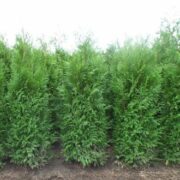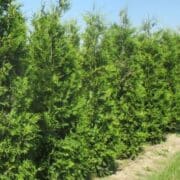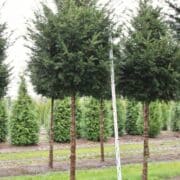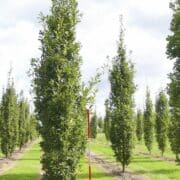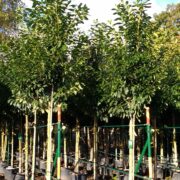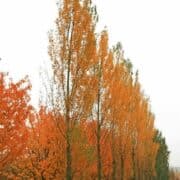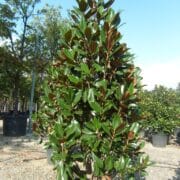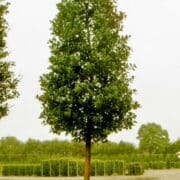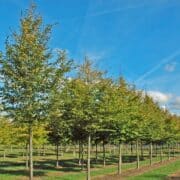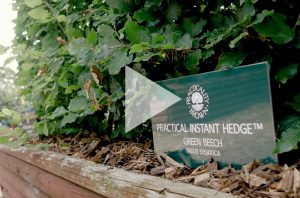Screening Trees
Trees are a great addition to almost any garden, creating structure and seasonal interest. Gardens provide a sanctuary and respite from the busy world and using trees to screen out or hide an undesirable view, creates some valuable privacy. Here we list our top 10 trees that are suitable for screening in gardens.
Position such trees well and they will make an ideal focal point, that they can be enjoyed now and for future generations.
Screening trees often have a clear stem to reach up to fence panel height of around 1.8-2m with a full-bushy canopy above. This type of screening is particularly useful if you are overlooked by neighbouring properties, would like to draw the eye towards a specific feature, or would like to retain lower level exposure i.e. of an attractive wall or area.
We can also supply feathered trees that have full growth from the ground upwards and offer the same screening ability.
Generally, evergreens are preferred for this purpose and can be planted densely to achieve maximum effect from the offset. However, planting a selection of trees, if space allows, can provide rich contrast and seasonal interest.
We can supply a range of quality trees for decorative or screening, which are particularly useful to create privacy in your garden.
Top 10 Screening Trees
- Ilex aquifolium (English Holly)
- Magnolia grandiflora Gallisoniensis (Magnolia Bull bay)
- Prunus laurocerasus (Cherry Laurel)
- Quercus ilex (Holm Oak)
- Taxus baccata (English Yew)
- Thuja occidentalis Brabant (White Cedar)
- Thuja plicata (Western Red Cedar)
- Carpinus betulus (Hornbeam)
- Populus nigra Italica (Lombardy Poplar)
- Quercus robur Fastigiata Koster (Cypress Oak)
Our Top 10 Trees for Screening and Privacy
Ilex aquifolium (English Holly)
The English Holly is a classic native evergreen tree with spiky leaves on younger plants but the leaves of older trees are much more likely to be smooth. Ilex aquifolium has small white flowers in spring and later followed by bright red berries, which are palatable to birds and small mammals after the first frosts of the season. Slow-growing when young, Holly matures into an attractive, pyramidal shape.
Ideal Conditions: Like many evergreens, it prefers well-drained soils and will not thrive in soils which have a propensity for water holding.
Maximum Height: height 12 metres+
Magnolia grandiflora Gallisoniensis (Bull bay)
This Magnolia is an evergreen that produces beautiful, large, white flowers in the summer, often up to 25 cm in diameter. As well as decorating this stunning tree, the blooms also create a sweet-citrus smelling aroma. It has large, ovoid leaves which are dark green and leathery on top, with a coppery, almost-furry underside. It has young shoots that are reddish, that change to a greyish brown at maturity. Due to its large leaves and bushy head at maturity, the Bull Bay makes for brilliant screening as well as an attractive feature.
Ideal Conditions: Grows well in most soils, must be sheltered and not north-facing.
Maximum Height: 15 metres
Prunus laurocerasus (Cherry Laurel)
Cherry Laurel is popularly used for screening due to its upright and bushy habit. These laurels produce small, sweet-smelling, white flowers, which grow in vertical racemes, about 12 cm long, followed by small, cherry-like fruit. It is also available in pleached form, which is excellent for screening in smaller gardens.
Ideal Conditions: Plant in sun to shade, prefers moist slightly acidic cultivated soil.
Maximum Height: 5-8 metres
Quercus ilex (Holm Oak)
Holm, or Holly, Oak is a very popular evergreen tree that has leathery serrated holly-like leaves.
Quercus ilex regenerates very well after pruning, eventually creating a dense all year round screen. It is a majestic evergreen tree, being hardy and robust too; resistant to salt-spray from the sea, and from urban pollution.
Ideal Conditions: Grows well in most soils, coastal regions and urban environments.
Maximum Height: 25 metres
Taxus baccata (English Yew)
The English Yew is probably the classic evergreen tree, it is elegant and long-lived.
Leaves are small and dark green and whorl on the branch. Seeds grow individually in arils, which are red, fruit-like shells with an open end, giving added interest to these trees. Taxus baccata rejuvenates itself remarkably well if pruned in the early spring.
Ideal Conditions: Thrives best on free draining lighter soil.
Maximum Height: up to 12 metres
Thuja occidentalis Brabant (White Cedar)
The White Cedar is an attractive, evergreen conifer that has a compact, conical habit with slightly drooped branches. It has a reddish-brown bark that peels off in thin strips. Due to its dense habit, this tree is ideal for privacy screening. The RHS has given this tree an Award of Merit. Thujia
Ideal Conditions: It is a highly tolerant tree and can grow in most conditions.
Maximum Height: 20 metres
Thuja plicata (Western Red Cedar)
Western Red Cedar is an impressive evergreen conifer, with densely branched, making it a great tree for screening. Its glossy dark-green scales very aromatic. Thuja is usually frost-hardy and tolerant of urban pollution.
Ideal Conditions: Plant in sun to light shade in all types of well-drained soils
Maximum Height: 20-25 metres
Carpinus betulus (Hornbeam)
Hornbeam is a popular deciduous tree, ideal for screening, whether in pleached or as a natural fastigate/column, due to its ability to regenerate after pruning. It has a very vertical trunk with smooth dark-grey bark and the leaves are a fresh green colour in spring and turn golden yellow in the autumn.
Ideal Conditions: Carpinus betulus is hardy and can be planted in sun or shade and in all soil types.
Maximum Height: 20 metres plus
Populus nigra Italica (Lombardy Poplar)
The Lombardy Poplar is a narrowly columnar deciduous tree and makes a good specimen for screening and as a riverbank tree. A fine architectural columnar tree, it features crimson male catkins before the bright green ovate leaves open in early spring.
Ideal Conditions: It thrives on most soils including those prone to lying wet in winter.
Maximum Height: up to 30 metres
Quercus robur Fastigiata Koster (Cypress Oak)
Cypress Oak is a fiercely upright variety of oak, forming a tightly regular and narrow crown, making it perfect for restricted spaces. This pretty tree has a deeply lobed, glossy green leaf, characteristic of the Oak; the foliage turns golden brown in the autumn and will remain on the tree throughout the winter period in less exposed conditions
Ideal Conditions: It will tolerate most soils, but is particularly tolerant of heavy clay.
Maximum Height: 15 metres
- Thuja plicata
- Thuja occidentalis Brabant
- Taxus baccata
- Quercus robur Fastigiata Koster
- Quercus Ilex
- Prunus laurocerasus
- Populus nigra Italica
- Magnolia grandiflora Gallisoniensis
- Ilex aquifolium
- Carpinus betulus

